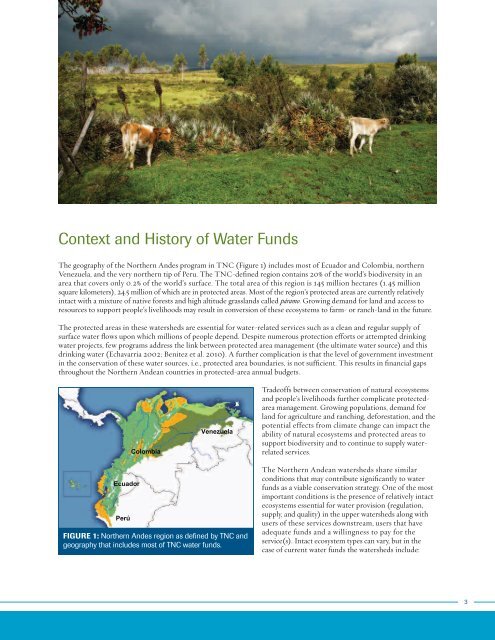Water Funds - Natural Capital Project
Water Funds - Natural Capital Project Water Funds - Natural Capital Project
Water Fund GoalsEach water fund has its own set of objectives and goals, but, in general, water funds invest in conservation of watersheds inorder to accomplish the following:1) improve or maintain water quality and water quantity for downstream users;2) maintain regular flows of water throughout the year;3) maintain or enhance natural ecosystem biodiversity, both freshwater and terrestrial; and4) improve or maintain human well-being and quality of life for upstream human communities.Using watershed conservation as a common objective water funds create:5) a multi-institutional governing body bringing together public and private partners;6) opportunities to avoid costs of water treatment by investing in nature instead of infrastructure; and7) sustainable financing for long-term conservation efforts.These goals and the mechanisms by which they are achieved will vary and can be more explicit depending on the situation,but they are the general framework for water fund operation.2 Water funds: Protecting Watersheds for Nature and People
Context and History of Water FundsThe geography of the Northern Andes program in TNC (Figure 1) includes most of Ecuador and Colombia, northernVenezuela, and the very northern tip of Peru. The TNC-defined region contains 20% of the world’s biodiversity in anarea that covers only 0.2% of the world’s surface. The total area of this region is 145 million hectares (1.45 millionsquare kilometers), 24.5 million of which are in protected areas. Most of the region’s protected areas are currently relativelyintact with a mixture of native forests and high altitude grasslands called páramo. Growing demand for land and access toresources to support people’s livelihoods may result in conversion of these ecosystems to farm- or ranch-land in the future.The protected areas in these watersheds are essential for water-related services such as a clean and regular supply ofsurface water flows upon which millions of people depend. Despite numerous protection efforts or attempted drinkingwater projects, few programs address the link between protected area management (the ultimate water source) and thisdrinking water (Echavarria 2002; Benitez et al. 2010). A further complication is that the level of government investmentin the conservation of these water sources, i.e., protected area boundaries, is not sufficient. This results in financial gapsthroughout the Northern Andean countries in protected-area annual budgets.ColombiaVenezuelaTradeoffs between conservation of natural ecosystemsand people’s livelihoods further complicate protectedareamanagement. Growing populations, demand forland for agriculture and ranching, deforestation, and thepotential effects from climate change can impact theability of natural ecosystems and protected areas tosupport biodiversity and to continue to supply waterrelatedservices.EcuadorPerúFIGURE 1: Northern Andes region as defined by TNC andgeography that includes most of TNC water funds.The Northern Andean watersheds share similarconditions that may contribute significantly to waterfunds as a viable conservation strategy. One of the mostimportant conditions is the presence of relatively intactecosystems essential for water provision (regulation,supply, and quality) in the upper watersheds along withusers of these services downstream, users that haveadequate funds and a willingness to pay for theservice(s). Intact ecosystem types can vary, but in thecase of current water funds the watersheds include:3
- Page 1 and 2: Protecting watersheds for nature an
- Page 3: IntroductionEcosystem services, the
- Page 7 and 8: Watershed orWater fund nameAssociat
- Page 9 and 10: The end users of the water services
- Page 11 and 12: Component 4: Water Funds and Conser
- Page 13 and 14: Replication: Challenges and Obstacl
- Page 15 and 16: ReferencesAsquith, N. and Wunder, S
Context and History of <strong>Water</strong> <strong>Funds</strong>The geography of the Northern Andes program in TNC (Figure 1) includes most of Ecuador and Colombia, northernVenezuela, and the very northern tip of Peru. The TNC-defined region contains 20% of the world’s biodiversity in anarea that covers only 0.2% of the world’s surface. The total area of this region is 145 million hectares (1.45 millionsquare kilometers), 24.5 million of which are in protected areas. Most of the region’s protected areas are currently relativelyintact with a mixture of native forests and high altitude grasslands called páramo. Growing demand for land and access toresources to support people’s livelihoods may result in conversion of these ecosystems to farm- or ranch-land in the future.The protected areas in these watersheds are essential for water-related services such as a clean and regular supply ofsurface water flows upon which millions of people depend. Despite numerous protection efforts or attempted drinkingwater projects, few programs address the link between protected area management (the ultimate water source) and thisdrinking water (Echavarria 2002; Benitez et al. 2010). A further complication is that the level of government investmentin the conservation of these water sources, i.e., protected area boundaries, is not sufficient. This results in financial gapsthroughout the Northern Andean countries in protected-area annual budgets.ColombiaVenezuelaTradeoffs between conservation of natural ecosystemsand people’s livelihoods further complicate protectedareamanagement. Growing populations, demand forland for agriculture and ranching, deforestation, and thepotential effects from climate change can impact theability of natural ecosystems and protected areas tosupport biodiversity and to continue to supply waterrelatedservices.EcuadorPerúFIGURE 1: Northern Andes region as defined by TNC andgeography that includes most of TNC water funds.The Northern Andean watersheds share similarconditions that may contribute significantly to waterfunds as a viable conservation strategy. One of the mostimportant conditions is the presence of relatively intactecosystems essential for water provision (regulation,supply, and quality) in the upper watersheds along withusers of these services downstream, users that haveadequate funds and a willingness to pay for theservice(s). Intact ecosystem types can vary, but in thecase of current water funds the watersheds include:3



